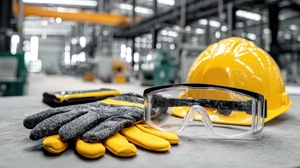A Blueprint for Mental Wellbeing of Construction Workers

Introduction
OSHA's mission is to ensure safe working conditions. They are expanding their focus to include mental health hazards due to the significant impact of work-related stress in the U.S. Work-related stress is widespread, leading to 120,000 deaths annually. Investing in mental health yields a $4 return for every $1 spent. The pandemic has exacerbated mental health issues, with almost half of Americans reporting symptoms of anxiety or depression in 2021. It's time to recognize mental health hazards as occupational hazards and collaborate to protect workers' mental health. OSHA provides resources during Mental Health Awareness Month, including a workplace stress toolkit. They aim to promote awareness, encourage open discussions, and address labor violations to ensure workers' safety and well-being.
The construction industry plays a crucial role in global economic growth by developing infrastructure and housing, but the strenuous nature of the work can impact workers' physical and mental health. Recognizing this, the CDC's NIOSH (National Institute for Occupational Safety and Health) launched the "Impact Wellbeing" initiative to enhance construction workers' overall wellness. Despite the industry's high suicide rate, stigma prevents many workers from seeking help. The Department of Labor's Mental Health at Work Initiative aims to address these challenges by raising awareness about mental health, dispelling myths, and promoting safety programs that prioritize workers' well-being, aligning with OSHA's vision for safer, healthier workplaces.
Challenges Faced by Construction Workers
Construction workers face a unique set of challenges that can adversely affect their mental wellbeing. The physical demands of the job, long hours, exposure to harsh weather conditions, and strenuous labor can lead to chronic physical health issues. However, the mental health challenges are often overlooked. Some of the major challenges include:
Job Insecurity
The construction industry is often subject to economic fluctuations, leading to job insecurity for many workers. Uncertainty about job stability can trigger anxiety and stress.
Physical Strain
The physically demanding nature of construction work can lead to injuries and chronic pain, which can, in turn, contribute to mental health issues.
Isolation Risk
Construction workers often work in isolation or in small teams, which can lead to feelings of loneliness and isolation, increasing the risk of depression.
Working Hours
Many construction projects require long working hours, including weekends and holidays. This can result in a poor work-life balance, affecting family relationships and overall mental wellbeing.
Substance Abuse
The stressful and physically demanding nature of construction work can make workers susceptible to substance abuse as a coping mechanism.
Evaluating Employee Wellbeing in the Construction Industry
Evaluating employee wellbeing in construction involves considering safety, health, job stability, and compensation. The CDC's NIOSH "Impact Wellbeing" initiative aims to address these factors comprehensively, improving workers' quality of life and making the industry more appealing and sustainable. Prioritizing employee wellbeing is key for construction companies, starting with a thorough evaluation of sector challenges and opportunities.
Injury Rates
The construction industry often reports high injury and fatality rates. It is essential to understand the severe consequences of safety lapses in the industry. Analyzing injury data can provide insights into the areas where safety measures need improvement, ultimately enhancing the wellbeing of the workforce.
Work-Related Illnesses
Exposure to hazardous substances or environmental factors can lead to work-related illnesses among construction workers. Assessing the impact of such illnesses on employee health is vital. It highlights the need for better preventive measures, appropriate training and healthcare support. Click here to enroll in the relevant HAZWOPER training.
Mental Health
Stress, anxiety, depression, and other mental health issues are increasingly prevalent in the construction industry. The demanding nature of the work, coupled with high-pressure deadlines, can take a toll on mental wellbeing. Addressing mental health concerns is crucial to ensuring overall employee wellbein
Substance Abuse
High-stress environments like construction can contribute to substance abuse issues, including alcohol and drug use. Understanding the prevalence of substance abuse and providing appropriate support and resources can have a significant impact on employee wellbeing.
Work Hours
Construction workers often put in long hours, which can negatively impact their work-life balance. Evaluating the extent of overtime and its effects on employee wellbeing is crucial for ensuring a healthy work-life equilibrium.
Job Stability
The construction industry's job stability, including job turnover and layoffs, is a significant factor in assessing employee wellbeing. Uncertainty regarding employment can lead to stress and anxiety among workers.
Wages and Salaries
Analyzing data on wages and salaries can reveal whether construction workers are adequately compensated for the risks and demands of their work. Fair and competitive compensation is essential for ensuring the wellbeing of employees.
Benefits
Data on benefits such as healthcare coverage, retirement plans, and other perks can indicate how well construction companies support their employees' wellbeing. Comprehensive benefits packages can go a long way in ensuring the health and security of workers.
Access to Training
Information on the availability and utilization of training programs for safety and skill development is essential. A well-trained workforce is safer and more equipped to handle the challenges of the construction industry, improving overall employee wellbeing.
Education Levels
The educational background of construction workers can affect their job prospects and overall job satisfaction. Addressing educational disparities and providing opportunities for skill development can enhance employee wellbeing.
Age and Gender
Understanding the age and gender distribution of construction workers can reveal disparities in wellbeing and opportunities within the industry. Tailoring support and resources to address specific demographic needs is essential.
Ethnicity and Diversity
Assessing the ethnic and racial composition of the construction workforce is crucial for evaluating diversity and inclusion efforts. Promoting diversity and inclusion is not only a moral imperative but also a key driver of employee wellbeing.
Unionization Rates
Unionized workers in the construction industry often have better working conditions and benefits. Unionization can significantly impact employee wellbeing by ensuring fair wages, safer working conditions, and job security.
How HAZWOPER Regulations Keep Employees Secure?
HAZWOPER regulations, overseen by OSHA in the U.S., are crucial for protecting employees handling hazardous materials. They ensure comprehensive training for workers to prevent accidents and respond effectively. Hazard identification and assessment are key, allowing employers to develop safety plans and mitigate risks. Personal protective equipment (PPE) is essential to shield employees from exposure, including respirators and chemical-resistant clothing.
HAZWOPER also emphasizes site control, restricting access to trained personnel, and mandates medical surveillance programs for early health issue detection. Emergency response plans prioritize safety in hazardous scenarios, while decontamination procedures minimize contamination risks. Evacuation and rescue protocols ensure the safety of all involved. Overall, HAZWOPER's focus on training, assessment, PPE, and emergency planning safeguards employees and communities from hazardous materials, underscoring a commitment to workplace safety and well-being.
Industry-specific Surveys
Surveys and studies conducted by industry organizations, government agencies, or research institutions can offer detailed insights into employees' perceptions of their wellbeing, safety, and overall job satisfaction.
By recognizing and implementing practical operational changes in construction practices, you can enhance employee retention and enable them to excel in their respective roles, ultimately motivating them to reach their full potential. Below, you'll discover some valuable guidance and resources designed specifically for the construction industry to embed the well-being of construction professionals deeply within your workplace culture.
Conclusion
The mental health of construction workers is often overlooked despite the industry's demanding nature. The CDC's NIOSH Impact Wellbeing initiative offers a comprehensive approach to address mental health issues by promoting awareness and prevention strategies. Integrating this initiative into workplace culture is crucial. Additionally, HAZWOPER OSHA Training offers courses tailored to enhance employee health and safety. Focusing on implementing safety protocols on construction sites and prioritizing the safety of workers is also an important aspect of improving the overall well-being and mental health of construction workers.
References:
U.S. Department of Labor Blog. (2023, May 4). Good Headspace Helps Make a Safe Workplace. Website https://blog.dol.gov/2023/05/04/good-headspace-helps-make-a-safe-workplace
OHS. (2023, Oct 18). Breaking the Mental Health Stigma in Construction. Website https://ohsonline.com/Articles/2023/10/18/Breaking-the-Mental-Health-Stigma-in-Construction.aspx

 EN |
EN |  ES
ES






























































































































